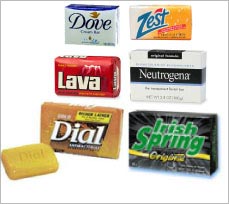
Soaps and soap products can be divided according to their intended use as personal care products (washing agents), laundry detergents and technical soaps.
According to SWW, personal care soaps are classified as semi-toilet soaps, toilet and special purpose and is divided into:
- half-toilet soaps in pieces,
- toilet and special soaps in pieces,
- liquid toilet soaps,
- paste toilet soaps.
Laundry detergents, in which the basic ingredient is soap, are classified according to the EPS in various categories of detergents. These are:
- laundry soaps: in pieces, in powder, in granules, soap shavings, soap flakes, soap threads,
- fatty acid washing pastes (tj. based on soaps),
- fatty acid washing liquids (tj. based on soaps),
- washing powders based on fatty acids with different amounts of these acids (i.e.. made on the basis of soaps, with different content in the product).
Technical soaps include:
- molded technical soaps: textile soda, textile potassium, Marseilles,
- greasy technical soaps (grey),
- powdered technical soaps.
Within individual categories, washing and washing agents may differ in the content of soaps obtained from different fatty materials and the total soap content in the product. Individual products, except the soaps, may contain synthetic surfactants and other ingredients that enhance the performance of the product.
Soaps and soap products can be more clearly divided into two product groups, taking into account the widespread use of soaps, and factors, which shape the usefulness of these products.
Household soaps belong to the first group, half-toilet, toilet and medicinal. They are common soaps. Particular categories of soap in this group differ in the amount and type of additives introduced in the packaging process to sodium basic soaps with similar properties.
The second group are special soaps, the use of which applies to selected groups of users or specific areas of economic activity. The different types of soaps in this group, because of their intended use, differ from each other in the composition of the soap base, thus the type and amount of fatty acid salts, specific additives, the method of production and the form of the final product.